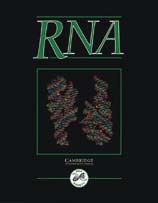Crossref Citations
This article has been cited by the following publications. This list is generated based on data provided by
Crossref.
Nakamura, Yoshikazu
Ito, Koichi
and
Ehrenberg, Måns
2000.
Mimicry Grasps Reality in Translation Termination.
Cell,
Vol. 101,
Issue. 4,
p.
349.
Dontsova, Maria
Frolova, Ludmila
Vassilieva, Julia
Piendl, Wolfgang
Kisselev, Lev
and
Garber, Maria
2000.
Translation termination factor aRF1 from the archaeon Methanococcus jannaschii is active with eukaryotic ribosomes.
FEBS Letters,
Vol. 472,
Issue. 2-3,
p.
213.
Kisselev, L. L.
Oparina, N. Yu.
and
Frolova, L. Yu.
2000.
Class-1 polypeptide chain release factors are structurally and functionally similar to suppressor tRNAs and comprise different structural-functional families of prokaryotic/mitochondrial and eukaryotic/archaebacterial factors.
Molecular Biology,
Vol. 34,
Issue. 3,
p.
363.
Kisselev, Lev L.
and
Buckingham, Richard H.
2000.
Translational termination comes of age.
Trends in Biochemical Sciences,
Vol. 25,
Issue. 11,
p.
561.
Paulin, Fiona E.M
Campbell, Linda E
O'Brien, Kirsty
Loughlin, Jane
and
Proud, Christopher G
2001.
Eukaryotic translation initiation factor 5 (eIF5) acts as a classical GTPase-activator protein.
Current Biology,
Vol. 11,
Issue. 1,
p.
55.
Chavatte, Laurent
Frolova, Ludmila
Kisselev, Lev
and
Favre, Alain
2001.
The polypeptide chain release factor eRF1 specifically contacts the s4UGA stop codon located in the A site of eukaryotic ribosomes.
European Journal of Biochemistry,
Vol. 268,
Issue. 10,
p.
2896.
Kervestin, Stéphanie
Frolova, Ludmila
Kisselev, Lev
and
Jean‐Jean, Olivier
2001.
Stop codon recognition in ciliates:
Euplotes
release factor does not respond to reassigned UGA codon
.
EMBO reports,
Vol. 2,
Issue. 8,
p.
680.
Seit-Nebi, Alim
Frolova, Ludmila
Justesen, Just
and
Kisselev, Lev
2001.
Class-1 translation termination factors: invariant GGQ minidomain is essential for release activity and ribosome binding but not for stop codon recognition.
Nucleic Acids Research,
Vol. 29,
Issue. 19,
p.
3982.
Bulygin, Konstantin N
Repkova, Marina N
Ven'yaminova, Aliya G
Graifer, Dmitri M
Karpova, Galina G
Frolova, Ludmila Yu
and
Kisselev, Lev L
2002.
Positioning of the mRNA stop signal with respect to polypeptide chain release factors and ribosomal proteins in 80S ribosomes.
FEBS Letters,
Vol. 514,
Issue. 1,
p.
96.
Ito, Koichi
Frolova, Ludmila
Seit-Nebi, Alim
Karamyshev, Andrey
Kisselev, Lev
and
Nakamura, Yoshikazu
2002.
Omnipotent decoding potential resides in eukaryotic translation termination factor eRF1 of variant-code organisms and is modulated by the interactions of amino acid sequences within domain 1.
Proceedings of the National Academy of Sciences,
Vol. 99,
Issue. 13,
p.
8494.
Janzen, Deanna M.
Frolova, Lyudmila
and
Geballe, Adam P.
2002.
Inhibition of Translation Termination Mediated by an Interaction of Eukaryotic Release Factor 1 with a Nascent Peptidyl-tRNA.
Molecular and Cellular Biology,
Vol. 22,
Issue. 24,
p.
8562.
Seit‐Nebi, Alim
Frolova, Ludmila
and
Kisselev, Lev
2002.
Conversion of omnipotent translation termination factor eRF1 into ciliate‐like UGA‐only unipotent eRF1.
EMBO reports,
Vol. 3,
Issue. 9,
p.
881.
Le Goff, Catherine
Zemlyanko, Olga
Moskalenko, Svetlana
Berkova, Nadia
Inge‐Vechtomov, Sergei
Philippe, Michel
and
Zhouravleva, Galina
2002.
Mouse GSPT2, but not GSPT1, can substitute for yeast eRF3 in vivo.
Genes to Cells,
Vol. 7,
Issue. 10,
p.
1043.
Chavatte, Laurent
Seit-Nebi, Alim
Dubovaya, Vera
and
Favre, Alain
2002.
The invariant uridine of stop codons contacts the conserved NIKSR loop of human eRF1 in the ribosome.
The EMBO Journal,
Vol. 21,
Issue. 19,
p.
5302.
Mora, Liliana
Zavialov, Andrei
Ehrenberg, Måns
and
Buckingham, Richard H.
2003.
Stop codon recognition and interactions with peptide release factor RF3 of truncated and chimeric RF1 and RF2 from Escherichia coli.
Molecular Microbiology,
Vol. 50,
Issue. 5,
p.
1467.
Bulygin, Konstantin N
A. Demeshkina, Natalia
Frolova, Ludmila Yu
Graifer, Dmitri M
Ven'yaminova, Aliya G
Kisselev, Lev L
and
Karpova, Galina G
2003.
The ribosomal A site‐bound sense and stop codons are similarly positioned towards the A1823–A1824 dinucleotide of the 18S ribosomal RNA.
FEBS Letters,
Vol. 548,
Issue. 1-3,
p.
97.
Chavatte, Laurent
Frolova, Ludmila
Laugâa, Philippe
Kisselev, Lev
and
Favre, Alain
2003.
Stop Codons and UGG Promote Efficient Binding of the Polypeptide Release Factor eRF1 to the Ribosomal A Site.
Journal of Molecular Biology,
Vol. 331,
Issue. 4,
p.
745.
Dubourg, Christèle
Toutain, Bertrand
Le Gall, Jean-Yves
Le Treut, André
and
Guenet, Lucienne
2003.
Promoter analysis of the human translation termination factor 1 gene.
Gene,
Vol. 316,
Issue. ,
p.
91.
Kapp, Lee D.
and
Lorsch, Jon R.
2004.
The Molecular Mechanics of Eukaryotic Translation.
Annual Review of Biochemistry,
Vol. 73,
Issue. 1,
p.
657.
Chapman, Bernice
and
Brown, Chris
2004.
Translation termination in Arabidopsis thaliana: characterisation of three versions of release factor 1.
Gene,
Vol. 341,
Issue. ,
p.
219.




